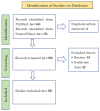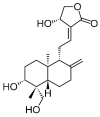Potential Plant-Based New Antiplasmodial Agent Used in Papua Island, Indonesia
- PMID: 37176870
- PMCID: PMC10181418
- DOI: 10.3390/plants12091813
Potential Plant-Based New Antiplasmodial Agent Used in Papua Island, Indonesia
Abstract
Resistance to antimalarial medicine remains a threat to the global effort for malaria eradication. The World Health Organization recently reported that artemisinin partial resistance, which was defined as delayed parasite clearance, was detected in Southeast Asia, particularly in the Greater Mekong subregion, and in Africa, particularly in Rwanda and Uganda. Therefore, the discovery of a potential new drug is important to overcome emerging drug resistance. Natural products have played an important role in drug development over the centuries, including the development of antimalarial drugs, with most of it influenced by traditional use. Recent research on traditional medicine used as an antimalarial treatment on Papua Island, Indonesia, reported that 72 plant species have been used as traditional medicine, with Alstonia scholaris, Carica papaya, Andrographis paniculata, and Physalis minima as the most frequently used medicinal plants. This review aimed to highlight the current research status of these plants for potential novel antiplasmodial development. In conclusion, A. paniculata has the highest potential to be developed as an antiplasmodial, and its extract and known bioactive isolate andrographolide posed strong activity both in vitro and in vivo. A. scholaris and C. papaya also have the potential to be further investigated as both have good potential for their antiplasmodial activities in vivo. However, P. minima is a less studied medicinal plant; nevertheless, it opens the opportunity to explore the potential of this plant.
Keywords: Papua Island; antiplasmodial; medicinal plants.
Conflict of interest statement
The authors declare no conflict of interest.
Figures









Similar articles
-
The use of antimalarial plants as traditional treatment in Papua Island, Indonesia.Heliyon. 2020 Dec 14;6(12):e05562. doi: 10.1016/j.heliyon.2020.e05562. eCollection 2020 Dec. Heliyon. 2020. PMID: 33344788 Free PMC article.
-
Antiplasmodial Activity and Phytochemical Constituents of Selected Antimalarial Plants Used by Native People in West Timor Indonesia.Turk J Pharm Sci. 2021 Feb 25;18(1):80-90. doi: 10.4274/tjps.galenos.2019.29000. Turk J Pharm Sci. 2021. PMID: 33634682 Free PMC article.
-
Antimalarial activity of medicinal plants from the Democratic Republic of Congo: A review.J Ethnopharmacol. 2015 Jul 1;169:76-98. doi: 10.1016/j.jep.2015.03.075. Epub 2015 Apr 8. J Ethnopharmacol. 2015. PMID: 25862959 Review.
-
HPLC-based activity profiling for antiplasmodial compounds in the traditional Indonesian medicinal plant Carica papaya L.J Ethnopharmacol. 2014 Aug 8;155(1):426-34. doi: 10.1016/j.jep.2014.05.050. Epub 2014 Jun 2. J Ethnopharmacol. 2014. PMID: 24892830
-
Andrographis paniculata (Burm.f.) Nees: Traditional uses, phytochemistry, pharmacological properties and quality control/quality assurance.J Ethnopharmacol. 2021 Jul 15;275:114054. doi: 10.1016/j.jep.2021.114054. Epub 2021 Apr 6. J Ethnopharmacol. 2021. PMID: 33831465 Review.
Cited by
-
Anti-Aging Potential of Plants of the Anak Dalam Tribe, Jambi, Indonesia.Pharmaceuticals (Basel). 2023 Sep 14;16(9):1300. doi: 10.3390/ph16091300. Pharmaceuticals (Basel). 2023. PMID: 37765107 Free PMC article. Review.
-
Medicinal plants used in Gabon for prophylaxis and treatment against COVID-19-related symptoms: an ethnobotanical survey.Front Pharmacol. 2024 Jul 5;15:1393636. doi: 10.3389/fphar.2024.1393636. eCollection 2024. Front Pharmacol. 2024. PMID: 39035990 Free PMC article.
-
Bioprospecting of Natural Products from Medicinal Plants.Plants (Basel). 2024 Dec 20;13(24):3556. doi: 10.3390/plants13243556. Plants (Basel). 2024. PMID: 39771254 Free PMC article.
References
-
- World Health Organization . World Malaria Report 2021. World Health Organization; Geneva, Switzerland: 2021.
-
- World Health Organization . World Malaria Report 2020—20 Years of Global Progress & Challenges. World Health Organization; Geneva, Switzerland: 2020.
-
- World Health Organization . World Malaria Report 2019. World Health Organization; Geneva, Switzerland: 2019.
-
- Kementerian Kesehatan Republik Indonesia . Profil Kesehatan Indonesia Tahun 2020. Kementerian Kesehatan Republik Indonesia; Jakarta, Indonesia: 2021.
Publication types
Grants and funding
LinkOut - more resources
Full Text Sources

